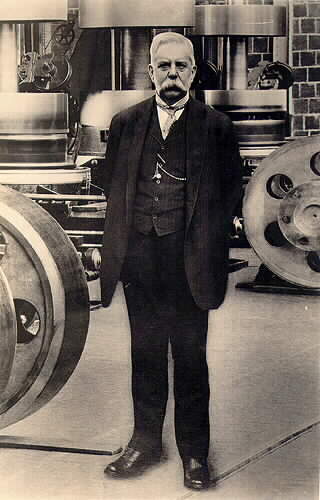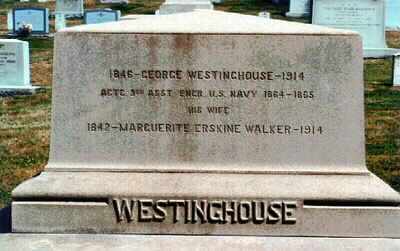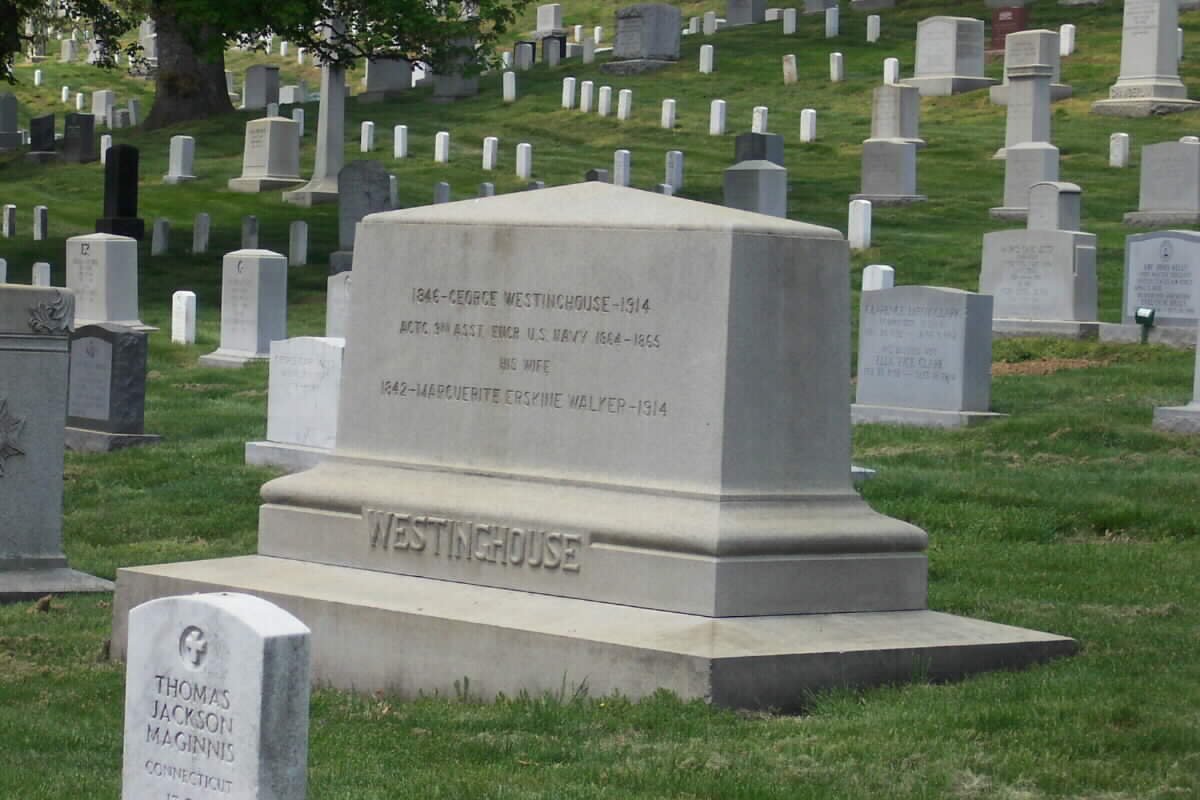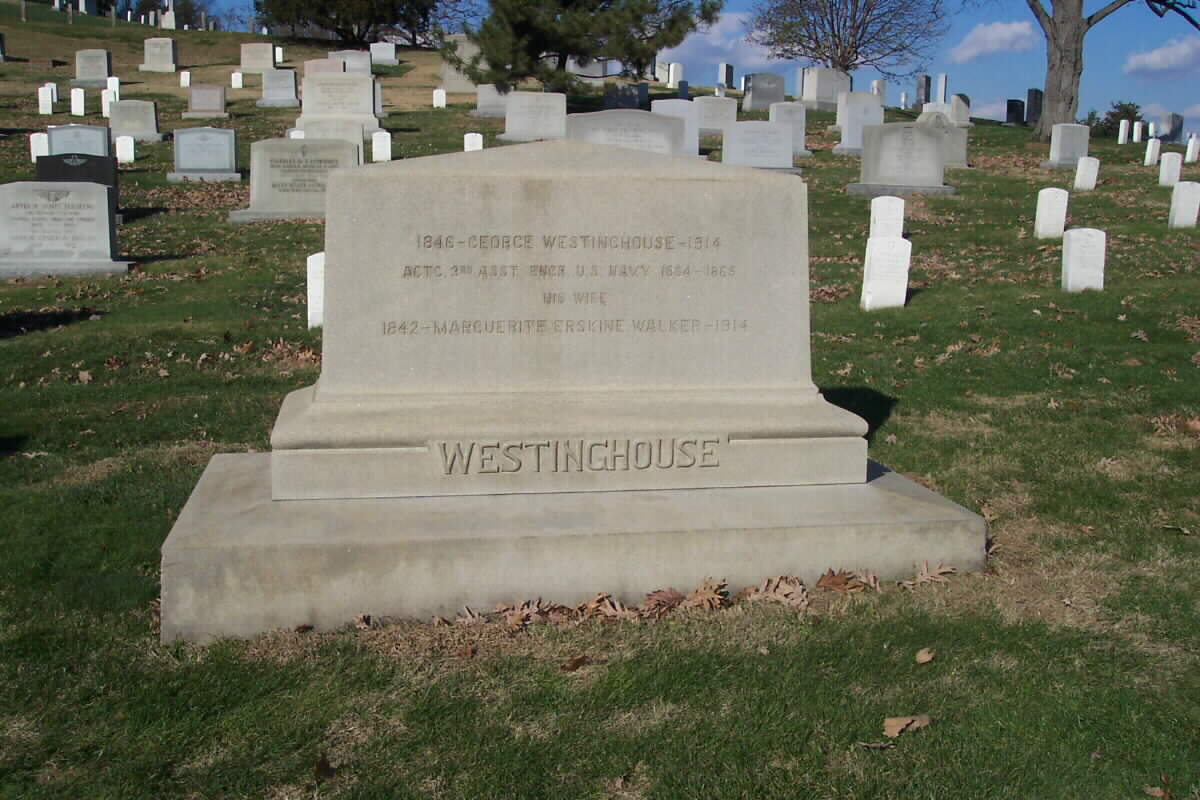He enlisted in the Navy at the age of sixteen when the Civil War broke out. During the War, he served in both the Navy and the Army.
After the war, he embarked on a career of inventing and manufacturing, his first invention being the device to replace derailed railroad cars and the air brake. He developed the Westinghouse Electric Company, but lost control of it during the financial panic and within four years had severed all ties and relationships with the company.
His health soon failed and he died on New York City on March 2, 1914 and was buried a few days later in Section 2 of Arlington National Cemetery.
His wife, Marguerite Erskine Walker Westinghouse, was born in 1841 and died at Lenox, Massachusetts on June 23, 1914, is buried with him.
MARGUERITE ERSKINE WALKER WESTINGHOUSE:
She met her husband, George, on a train. Both were young and creative; she an artist and he an inventor. Shortly after that chance meeting, on August 8, 1867, they were married, and remained a devoted couple. While George introduced his newly invented air brake throughout Europe, she traveled with him, offering encouragement and inspiration. George Westinghouse attributed whatever successes he might have had in life to his wife. Their love affair lasted a lifetime. Life for the Westinghouses was full and interesting. George purchased Solitude, their home in Pittsburgh, in 1871 as a surprise birthday present for his wife. She sculptured a bust of him in 1878. On the sixteenth year of their forty-six year marriage, they were blessed by the birth of their only child, George III. Together they decided to drill a gas well on their Pittsburgh property, which produced an abundant supply of natural gas at cheap rates. The door was now open for the development of the iron and steel industry in that city.
She purchased a telephone for the home in 1886. Even though the apparatus at that time could not transmit at a distance greater than 20 miles, ironically, it later provided the means for him to stay in communication with her throughout their life together. He acquired the rather nice habit of calling her daily.
The couple entertained employees as well as royalty. One party was of particular interest. A reception dinner was to be held for the American Society of Mechanical Engineers at the Blaine House, George and Marguerite’s winter residence in Washington, D.C. George was called out of town quite unexpectedly, so Marguerite took on full responsibility. When Marguerite found that more guests were to attend than had originally been anticipated, she quickly hired a construction crew from Pittsburgh to remove an exterior wall. A tented addition was then added; all walls were skillfully blended one into the other. No one suspected that what appeared to be a large elegant room was in reality a tent. The evening was a great success.
At the time of her death on June 23, 1914, she was living at Erskine Park in Lenox, Massachusetts – the Westinghouse summer home – and the place that she loved the most. However, without George, who had preceded her in death by three months, she was quoted to have said, “I have nothing to live for now.” Both are buried in Arlington Cemetery in Washington, D.C.
WESTINGHOUSE, GEORGE
- ACTG 3RD ASST ENGR USN
- VETERAN SERVICE DATES: Unknown
- DATE OF DEATH: 03/12/1914
- DATE OF INTERMENT: Unknown
BURIED AT: SECTION ED SITE 3418
WESTINGHOUSE, MARGUERITE E W/O GEORGE
- DATE OF DEATH: 06/23/1914
- DATE OF INTERMENT: Unknown
- BURIED AT: SECTION E D SITE 3418
- ARLINGTON NATIONAL CEMETERY
- WIFE OF GEORGE WESTINGHOUSE – 3RD ASST, ENGR, US NAVY
Michael Robert Patterson was born in Arlington and is the son of a former officer of the US Army. So it was no wonder that sooner or later his interests drew him to American history and especially to American military history. Many of his articles can be found on renowned portals like the New York Times, Washingtonpost or Wikipedia.
Reviewed by: Michael Howard




